 Buda Castle ( hu, Budavári Palota, german: link=no, Burgpalast) is the historical castle and palace complex of the
Buda Castle ( hu, Budavári Palota, german: link=no, Burgpalast) is the historical castle and palace complex of the History

Middle Ages
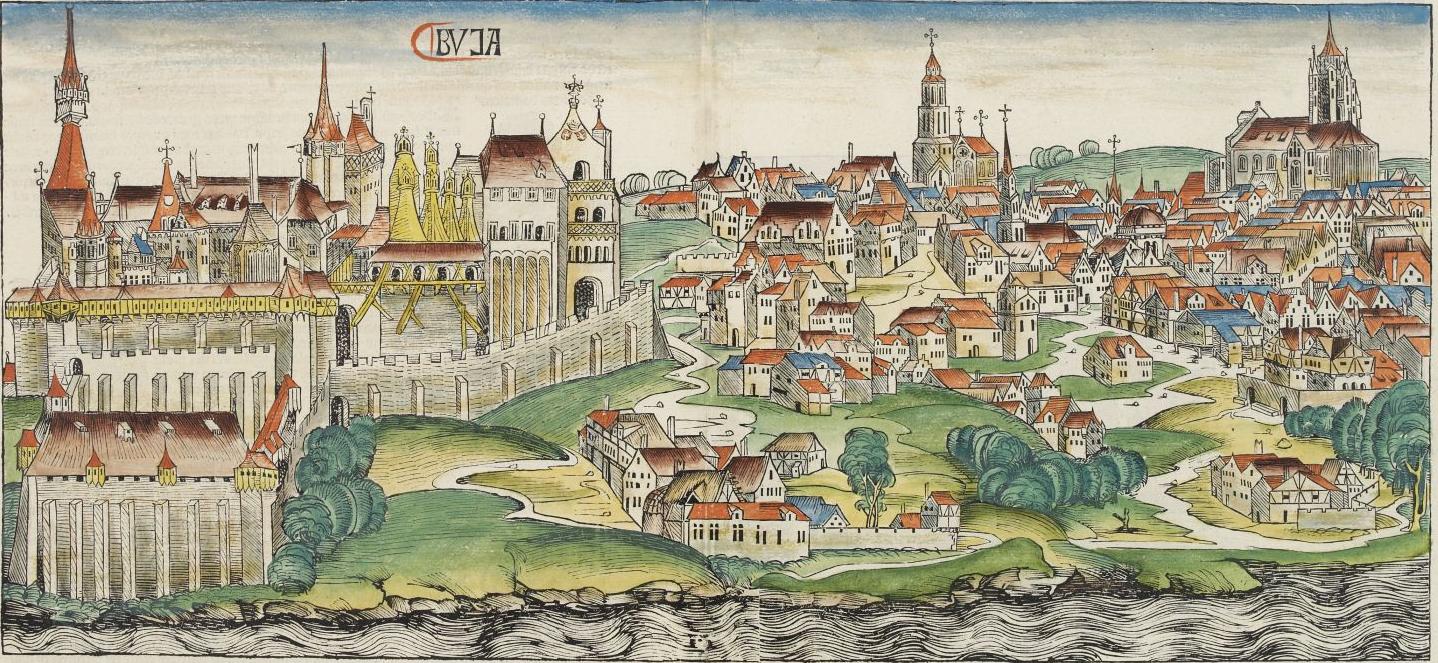
 The first royal residence on the Castle Hill was built by King Béla IV of Hungary between 1247 and 1265. It is uncertain whether it was situated on the southern tip of the hill or on the northern elevation, near the Kammerhof.
The oldest part of the present-day palace was built in the 14th century by Stephen, Duke of Slavonia, who was the younger brother of King Louis I of Hungary. Only the foundations remain of the castle keep, which was known as '' (Hungarian: ''István-torony''). The
The first royal residence on the Castle Hill was built by King Béla IV of Hungary between 1247 and 1265. It is uncertain whether it was situated on the southern tip of the hill or on the northern elevation, near the Kammerhof.
The oldest part of the present-day palace was built in the 14th century by Stephen, Duke of Slavonia, who was the younger brother of King Louis I of Hungary. Only the foundations remain of the castle keep, which was known as '' (Hungarian: ''István-torony''). The  In the last years of his reign Matthias Corvinus started construction of a new Renaissance palace on the eastern side of the Sigismund Courtyard, next to the Fresh Palace. The Matthias Palace remained unfinished because of the king's early death. The palace had a monumental red marble stairway in front of the façade. Matthias Corvinus was usually identified with
In the last years of his reign Matthias Corvinus started construction of a new Renaissance palace on the eastern side of the Sigismund Courtyard, next to the Fresh Palace. The Matthias Palace remained unfinished because of the king's early death. The palace had a monumental red marble stairway in front of the façade. Matthias Corvinus was usually identified with Ottoman Era
 After the
After the Destruction of the medieval castle
 The medieval palace was destroyed in the great siege of 1686 when Buda was captured by allied Christian forces.
In 1686, two years after the unsuccessful siege of Buda, a renewed Western European Christian campaign was started to take the city. This time the Holy League's army was much larger, consisting of 65,000–100,000 men, including German, Hungarian, Croat, Dutch, English, Spanish, Czech, Italian, French, Burgundian, Danish and Swedish soldiers and other Europeans as volunteers,
The medieval palace was destroyed in the great siege of 1686 when Buda was captured by allied Christian forces.
In 1686, two years after the unsuccessful siege of Buda, a renewed Western European Christian campaign was started to take the city. This time the Holy League's army was much larger, consisting of 65,000–100,000 men, including German, Hungarian, Croat, Dutch, English, Spanish, Czech, Italian, French, Burgundian, Danish and Swedish soldiers and other Europeans as volunteers, Early Baroque palace
 In 1715 a small Baroque palace was built according to the plans of Johann Hölbling. It was a simple rectangular building, with an inner court and a shorter side wing, which was later demolished. The Hölbling palace is identical with the core of the present-day palace, where the Baroque Court of the Budapest Historical Museum is now located.
The interior of the palace was left unfinished when work stopped in 1719. The
In 1715 a small Baroque palace was built according to the plans of Johann Hölbling. It was a simple rectangular building, with an inner court and a shorter side wing, which was later demolished. The Hölbling palace is identical with the core of the present-day palace, where the Baroque Court of the Budapest Historical Museum is now located.
The interior of the palace was left unfinished when work stopped in 1719. The Era of Maria Theresa
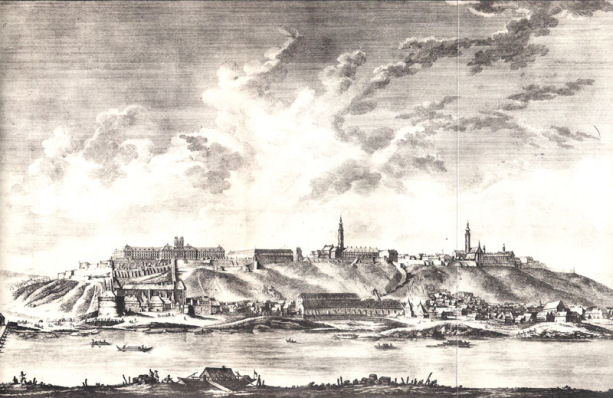 In 1748 Count Antal Grassalkovich, President of the Hungarian Chamber, appealed to the public to finish the derelict palace by means of public subscription. Palatine
In 1748 Count Antal Grassalkovich, President of the Hungarian Chamber, appealed to the public to finish the derelict palace by means of public subscription. Palatine  According to surviving historical documents, the layout of the palace followed Jadot's signed plans of 1749. The façades, some interior elements and the St. Sigismund Chapel are the works of
According to surviving historical documents, the layout of the palace followed Jadot's signed plans of 1749. The façades, some interior elements and the St. Sigismund Chapel are the works of Nuns and scholars
The future of the complex was uncertain; the Queen had no intention to use it as a royal residence, because she did not spend much time in Buda. In 1769 she gave one wing to theResidence of the Palatines
 Functional problems of the university remained unresolved, which led to the faculties being moved to Pest in 1783. In 1791 the palace became the residence of the new Habsburg
Functional problems of the university remained unresolved, which led to the faculties being moved to Pest in 1783. In 1791 the palace became the residence of the new Habsburg Era of Franz Joseph
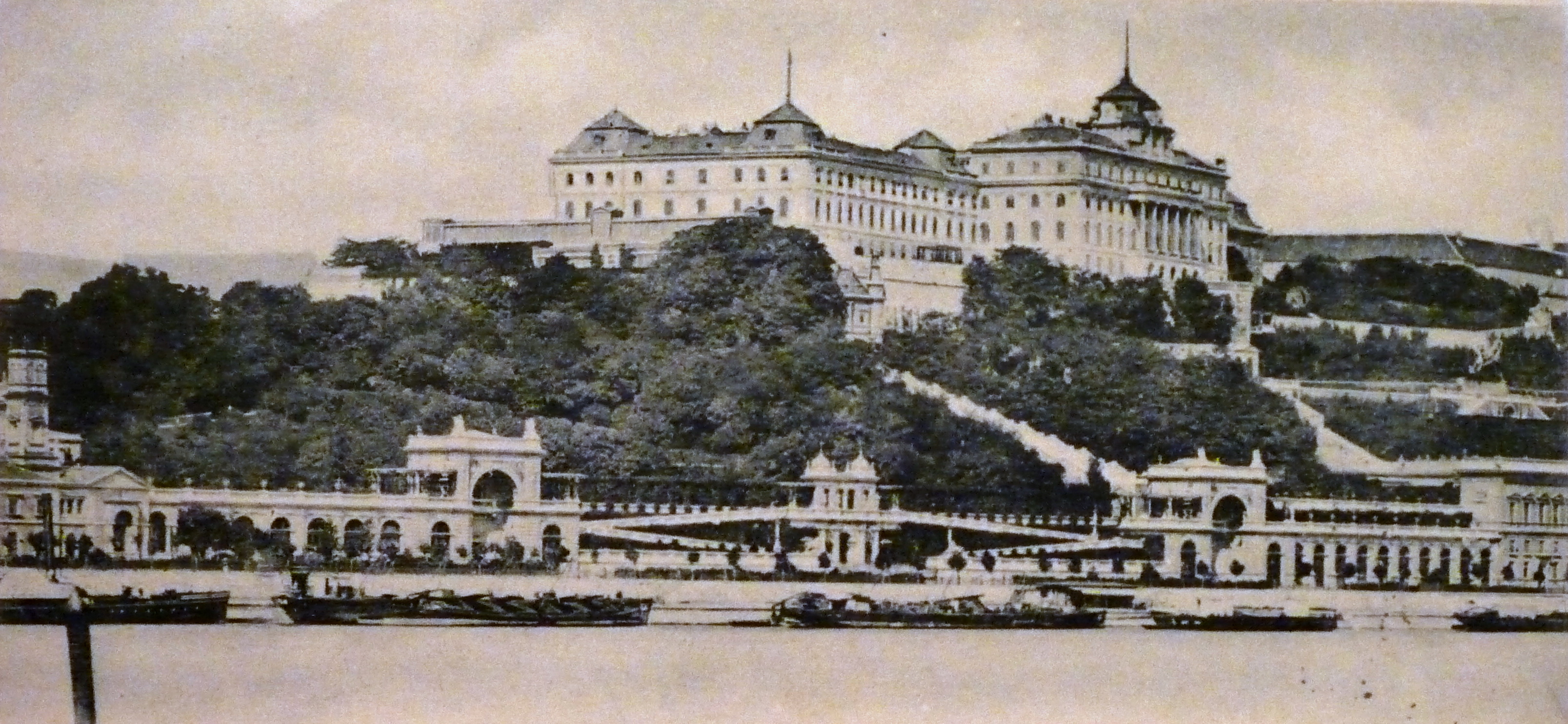 The palace was rebuilt between 1850 and 1856 by Josef Weiss and Carl Neuwirth. The 13-axis central wing was raised with a third storey and a squat attic-tower. The central
The palace was rebuilt between 1850 and 1856 by Josef Weiss and Carl Neuwirth. The 13-axis central wing was raised with a third storey and a squat attic-tower. The central 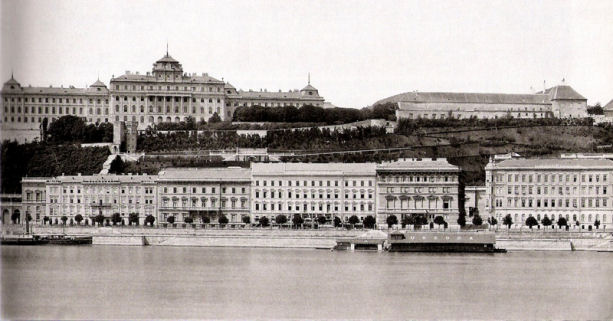 Emperor
Emperor 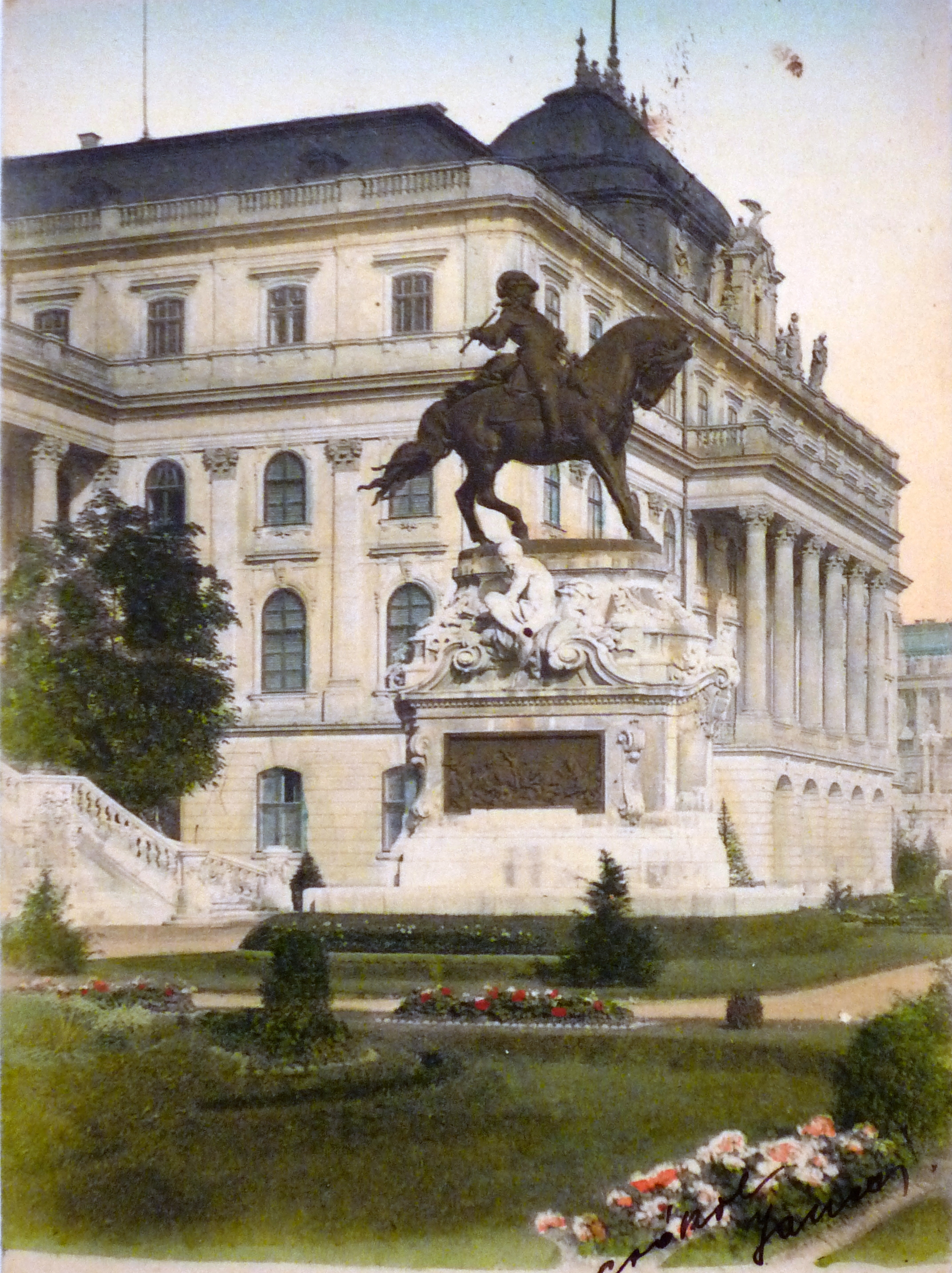 In 1882 Prime Minister
In 1882 Prime Minister  The work began on 1 May 1890, but Ybl died on 22 January 1891. His successor,
The work began on 1 May 1890, but Ybl died on 22 January 1891. His successor,  Hauszmann designed a new riding school in the former Újvilág terrace, which was now named the ''Csikós'' court, after the Csikós statue of György Vastagh (now in the western forecourt). In front of the long Danube façade, an equestrian statue was erected in honour of Prince Eugene of Savoy, the victorious leader of the Habsburg army in the Battle of Zenta. The eastern forecourt was closed off with a lavish wrought-iron rail, which ended in a pillar crowned by a statue of the legendary Turul, the sacred bird of the Magyars, spreading its wings above Budapest. Two flights of stairs led up to the Szent György tér, which was on much higher ground.
In the western forecourt, Hauszmann designed a new neo-Baroque guardhouse and rebuilt the old Royal Stables. The Royal Gardens on the southern hillside were famous for their precious plants, glass houses and picturesque terraces. In the middle of the gardens stood the Swiss House of Empress Elisabeth of Austria, Queen Elisabeth, furnished with Hungarian folk art objects. The house was built above the ruins of the medieval gatehouse, partially making use of them.
The interior of the palace was decorated and furnished exclusively with works of the leading Hungarian artists of the age. The Royal Palace was officially inaugurated in 1912. Contemporary critics praised it as the most outstanding Hungarian building of the turn of the 20th century.
Hauszmann designed a new riding school in the former Újvilág terrace, which was now named the ''Csikós'' court, after the Csikós statue of György Vastagh (now in the western forecourt). In front of the long Danube façade, an equestrian statue was erected in honour of Prince Eugene of Savoy, the victorious leader of the Habsburg army in the Battle of Zenta. The eastern forecourt was closed off with a lavish wrought-iron rail, which ended in a pillar crowned by a statue of the legendary Turul, the sacred bird of the Magyars, spreading its wings above Budapest. Two flights of stairs led up to the Szent György tér, which was on much higher ground.
In the western forecourt, Hauszmann designed a new neo-Baroque guardhouse and rebuilt the old Royal Stables. The Royal Gardens on the southern hillside were famous for their precious plants, glass houses and picturesque terraces. In the middle of the gardens stood the Swiss House of Empress Elisabeth of Austria, Queen Elisabeth, furnished with Hungarian folk art objects. The house was built above the ruins of the medieval gatehouse, partially making use of them.
The interior of the palace was decorated and furnished exclusively with works of the leading Hungarian artists of the age. The Royal Palace was officially inaugurated in 1912. Contemporary critics praised it as the most outstanding Hungarian building of the turn of the 20th century.
Interbellum years and World War II
 On 16 October 1944 a Nazi German commando unit, led by Otto Skorzeny, occupied the Royal Palace and forced the regent to abdicate. Buda Castle was the last major stronghold of Budapest held by Axis Powers of World War II, Axis forces during the Battle of Budapest, siege of Budapest between 29 December 1944 and 13 February 1945. The German and Hungarian forces defending the castle attempted to break the Soviet blockade on 11 February 1945, but failed. Allegedly the Soviet Red Army knew about their plans and had aimed heavy weapons at the possible escape routes hours earlier. This is considered one of the biggest disasters of Hungarian military history.
Heavy fights and artillery fire rendered the palace into ruins. The furniture vanished, roofs and vaults collapsed and the southern and western wings were burned out. The destruction was comparable to that of the great siege of 1686.
On 16 October 1944 a Nazi German commando unit, led by Otto Skorzeny, occupied the Royal Palace and forced the regent to abdicate. Buda Castle was the last major stronghold of Budapest held by Axis Powers of World War II, Axis forces during the Battle of Budapest, siege of Budapest between 29 December 1944 and 13 February 1945. The German and Hungarian forces defending the castle attempted to break the Soviet blockade on 11 February 1945, but failed. Allegedly the Soviet Red Army knew about their plans and had aimed heavy weapons at the possible escape routes hours earlier. This is considered one of the biggest disasters of Hungarian military history.
Heavy fights and artillery fire rendered the palace into ruins. The furniture vanished, roofs and vaults collapsed and the southern and western wings were burned out. The destruction was comparable to that of the great siege of 1686.
Reconstruction
Immediately after the war, archeological research was begun in order to unearth the remains of the Medieval Royal Palace (Buda Castle), medieval castle. The research, led by László Gerő (1946–1966) and László Zolnay (1967–1979), was likely the biggest castle excavation in Europe. The former Royal Gardens stairways, pavilions and glass houses, which dated from the turn of the 20th century, had to be sacrificed. Important parts of the former Sigismund and Matthias Palace had survived under the thick earth fill.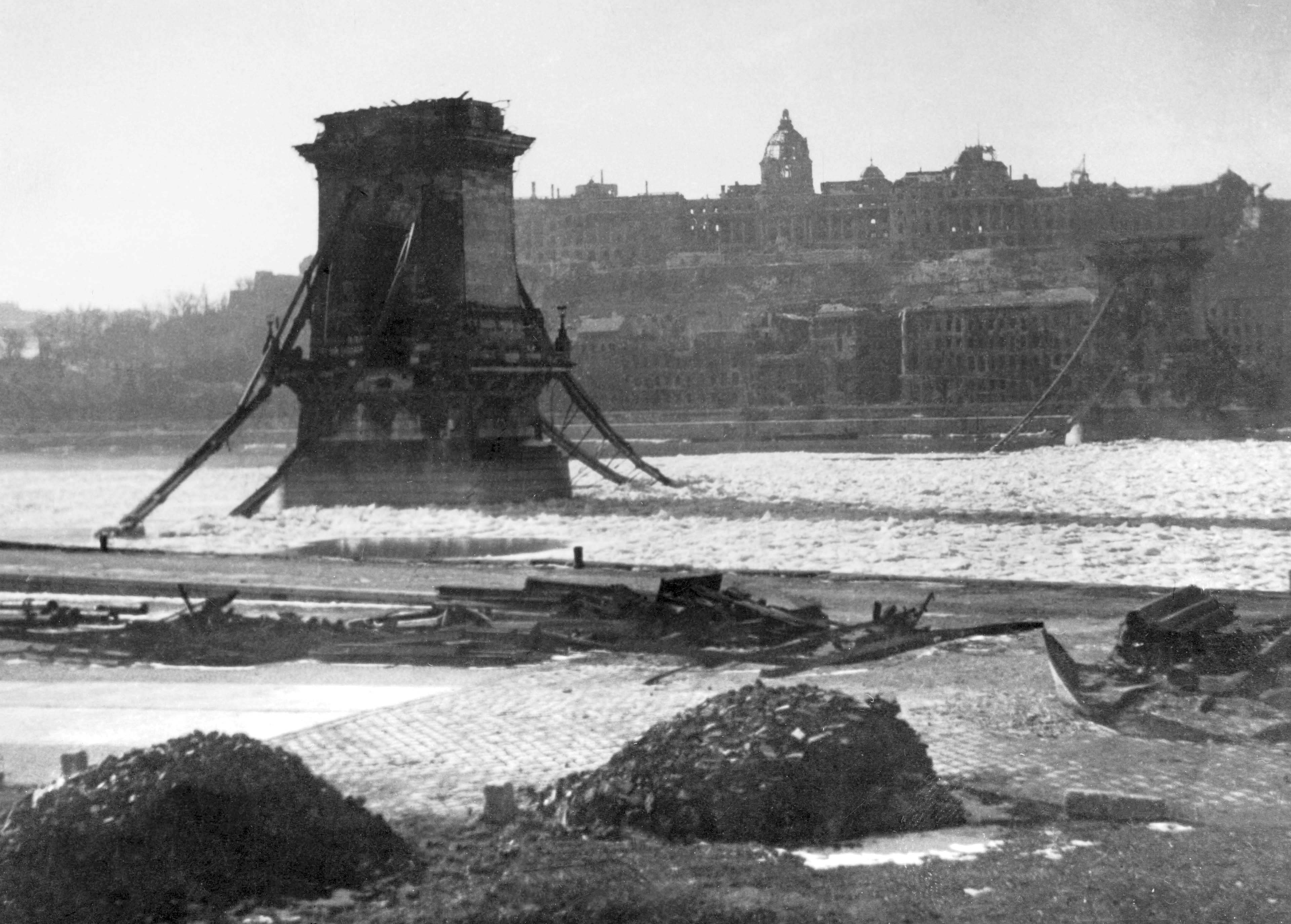 The first reconstruction plan of the medieval remains was written by László Gerő in 1950 and finalised in 1952. The reconstruction work was finished in 1966. Contrary to the generally accepted principles of historic reconstruction, the medieval fortification system was rebuilt in its entirety. Important elements like the 16th century Great Rondella and the medieval Gatehouse, the Mace Tower, the walls and the zwingers were reconstructed according to the results of the archaeological research and contemporary pictorial evidence. The low-lying southern wing of the Gothic palace was also reconstructed, together with the vaulted Gothic Hall and the Lower Church of the former Royal Chapel. Medieval-style gardens were planted in the zwingers. The foundation of the Stephen's Tower was unearthed, but as archaeological evidence was lacking, the tower was not reconstructed. The remains of the Broken Tower were covered again.
The large-scale reconstruction of the medieval fortifications substantially changed the cityscape of Budapest. At the time it was considered a highly successful project, reconciling historical authenticity with urban-planning demands.
In the 1970s, archeological research continued on the northern and western side of the palace, led by László Zolnay. It produced many important achievements, including the Late Gothic Buda Castle Statues. The Karakash Pasha Tower, in the ''Újvilág Garden'', was a Turkish-era tower demolished at the end of the 19th century. Photographic evidence enabled its reconstruction, but the new tower was only a copy of the original, and the details are not considered authentic.
The first reconstruction plan of the medieval remains was written by László Gerő in 1950 and finalised in 1952. The reconstruction work was finished in 1966. Contrary to the generally accepted principles of historic reconstruction, the medieval fortification system was rebuilt in its entirety. Important elements like the 16th century Great Rondella and the medieval Gatehouse, the Mace Tower, the walls and the zwingers were reconstructed according to the results of the archaeological research and contemporary pictorial evidence. The low-lying southern wing of the Gothic palace was also reconstructed, together with the vaulted Gothic Hall and the Lower Church of the former Royal Chapel. Medieval-style gardens were planted in the zwingers. The foundation of the Stephen's Tower was unearthed, but as archaeological evidence was lacking, the tower was not reconstructed. The remains of the Broken Tower were covered again.
The large-scale reconstruction of the medieval fortifications substantially changed the cityscape of Budapest. At the time it was considered a highly successful project, reconciling historical authenticity with urban-planning demands.
In the 1970s, archeological research continued on the northern and western side of the palace, led by László Zolnay. It produced many important achievements, including the Late Gothic Buda Castle Statues. The Karakash Pasha Tower, in the ''Újvilág Garden'', was a Turkish-era tower demolished at the end of the 19th century. Photographic evidence enabled its reconstruction, but the new tower was only a copy of the original, and the details are not considered authentic.
Modernization
 The government made a decision about reconstruction only in 1948. According to contemporary photos, all the important interiors were in a damaged state, but their reconstruction was technically possible. The new communist government of Hungary considered the Royal Palace a symbol of the former regime. Therefore, Hungarian leaders chose to thoroughly modernise the interior and exterior of the palace. Architectural trends played a part in the decision, as modernist architects had condemned the Hauszmann style as "too ornate".
The first modernist reconstruction plan was made by architect István Janáky in 1950. His controversial concept was later modified. In 1952 the Hungarian government asked for help from Poland, because they had successfully rebuilt Warsaw and, indeed, other cities. A delegation of Polish experts, led by the architectural historian Jan Zachwatowicz, proposed the rebuilding of the Hauszmann palace.
The government made a decision about reconstruction only in 1948. According to contemporary photos, all the important interiors were in a damaged state, but their reconstruction was technically possible. The new communist government of Hungary considered the Royal Palace a symbol of the former regime. Therefore, Hungarian leaders chose to thoroughly modernise the interior and exterior of the palace. Architectural trends played a part in the decision, as modernist architects had condemned the Hauszmann style as "too ornate".
The first modernist reconstruction plan was made by architect István Janáky in 1950. His controversial concept was later modified. In 1952 the Hungarian government asked for help from Poland, because they had successfully rebuilt Warsaw and, indeed, other cities. A delegation of Polish experts, led by the architectural historian Jan Zachwatowicz, proposed the rebuilding of the Hauszmann palace.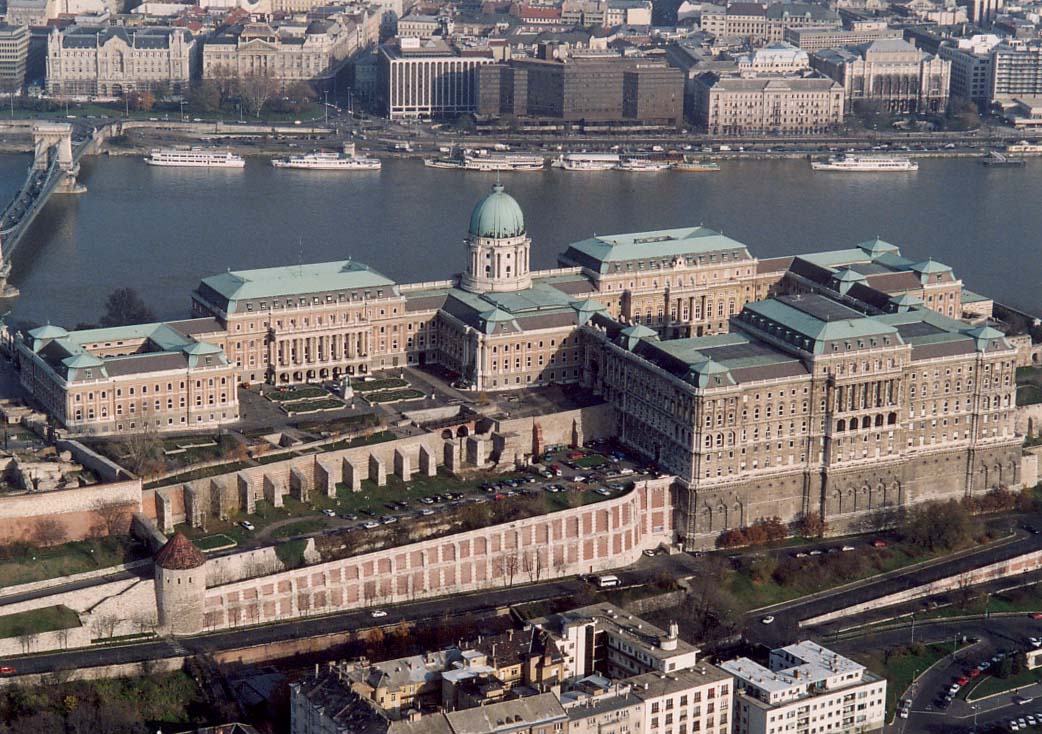 During the 1950s the palace was gutted and all the remaining interior, including the rooms and halls that were undamaged, were destroyed. Important exterior details, such as the main entrance, the Habsburg Steps, the dome, the Royal Stables, the guardhouse and the riding school were demolished, and the remaining façades were simplified. In Lions Court the ornate gates of ''King's Stairs'' and ''Diplomat's Stairs'' were demolished. The doorway of the castle church disappeared, as did the chapel. The detailed Neo-Baroque roofs were simplified and plain new windows were installed. The allegorical sculpture group of the tympanum was destroyed.
At the same time, medieval elements were uncovered and reconstructed. No precise drawings existed of them, so an approximate reconstruction of their appearance was done.
The modernist dome was designed by Lajos Hidasi in 1961 after Italian Baroque models. The palace was rebuilt by 1966, but the interior spaces were ready only in the 1980s. Buda Castle became a cultural centre, home to three museums and the National Széchényi Library.
During the 1950s the palace was gutted and all the remaining interior, including the rooms and halls that were undamaged, were destroyed. Important exterior details, such as the main entrance, the Habsburg Steps, the dome, the Royal Stables, the guardhouse and the riding school were demolished, and the remaining façades were simplified. In Lions Court the ornate gates of ''King's Stairs'' and ''Diplomat's Stairs'' were demolished. The doorway of the castle church disappeared, as did the chapel. The detailed Neo-Baroque roofs were simplified and plain new windows were installed. The allegorical sculpture group of the tympanum was destroyed.
At the same time, medieval elements were uncovered and reconstructed. No precise drawings existed of them, so an approximate reconstruction of their appearance was done.
The modernist dome was designed by Lajos Hidasi in 1961 after Italian Baroque models. The palace was rebuilt by 1966, but the interior spaces were ready only in the 1980s. Buda Castle became a cultural centre, home to three museums and the National Széchényi Library.
21st century
In March 2006 the National Office of Cultural Heritage finalised the long-term development plan of Buda Castle. Asserting that the modernisation in 1952–66 caused irreversible damage, they proposed the partial reconstruction of the façades, including the dome and the Habsburg Steps. No decision has been reached about the realization of the development plan. On 25 July 2007 Prime Minister Ferenc Gyurcsány chose the medieval King's Cellar in Buda Castle as the place to announce the list of the "most important public works projects", which was financed by European Union funds between 2007 and 2013. In 2008 an international consortium began to build an underground garage for 700 cars under the former Csikós Court. The developer was granted permission to demolish a section of the 15th-century castle wall. The demolition was carried out in spite of criticism from archeologists and the public. The area had been previously excavated by archeologists, who discovered many important finds, including medieval children's toys and a tooth from the pet leopard of King Matthias Corvinus. Additionally, the area outside the inner walls was used as a garbage dump during the 15th–17th centuries. However, financial difficulties interrupted the construction of the garage in 2009; work resumed for a short time in November 2011 but stopped again after the completion of the concrete basement slab. The government granted 1.3 billion forint for the completion of the project in 2015 after the half-built garage was bought by the state. The castle courtyard was also used as the setting for Katy Perry's 2010 music video, "Firework (Katy Perry song), Firework", part of her ''Teenage Dream (Katy Perry album), Teenage Dream'' album. The government formulated the "National Hauszmann Program" to revitalize and restore the castle in the period of 2019−2030. The program is named in honour of Alajos Hauszmann, the last major architect of the castle. The first phase of the program started in 2016. By 2019, the reconstruction of the Royal Riding hall, Stöckl Staircase and the Castle Guards' Barrack had been completed and the rebuilding of the Ybl Slope next to the barrack started. In the same year, further reconstructions are announced, namely Joseph Archduke's Palace, former Headquarters of the Ministry of Defense, and the former Ministry of Foreign Affairs' building. In 2019, the prime minister's residence was relocated to the Buda Castle from the Hungarian Parliament Building. The move was first planned in 2002 during the first Fidesz government, but was never carried out.Medieval wing
In 1958–1962, architect László Gerő partially recreated the façades of the Gothic castle facing the narrow southern, western and eastern courts. Only the ground and first floors were reconstructed; the castle was originally much higher. The unfinished façade stops at the level of the Baroque terrace above, with two windows opening towards the southern court and another two opening towards the eastern court. The four almost-identical windows are square, four-panel stone constructions of very fine Gothic craftsmanship, with their outer frames decorated with small columns. One window, which had been walled up, was discovered ''in situ'' during archeological research, and the others were reconstructed from fragments by the sculptor Ernő Szakál by means of anastylosis. The ground floor openings are simpler. An arched stone doorway gives access to the southern court from the cellar under the Gothic Hall. The façade was originally plastered. The whitewashed surface was decorated with a painted pattern in a rusty hue, resembling Rustication (architecture), rustication. Fragments of painted geometrical decoration, a common feature on the medieval buildings of Buda, were discovered on the eastern façade, but it was not restored. A Gothic balcony tower projects from the wall at the end of the eastern façade. Its reconstruction was a much debated issue, because the balcony tower goes above the level of the Baroque terrace, disturbing the harmonious panorama of the palace. On the other hand, it clearly indicates that there are higher, missing floors. The balcony tower is a two-storey structure standing on a wide stone basement. The first floor is a solid stone wall without any openings and the niche behind it belongs to the Gothic Hall. The second floor has a balcony with three windows; it is now closed off by a glass wall. Originally it would have been part of an important ceremonial room. The balcony is in the shape of half an octagon. The three Gothic double lancet windows are considered the most important architectural elements of the tower and the profiles; frames and mullions were restored in a simplified form, using many of the original stones. The tower is covered with a flat metal roof. The Gothic Hall is connected to Stephen's Castle (''István vár'') on the western side. It was named after Prince Stephen, Duke of Slavonia, the younger brother of King Louis I of Hungary. Built in the 1340s–1370s, it is the oldest part of the medieval royal palace. Only the foundation and three interconnected barrel-vaulted rooms survive. Stephen's Tower (''István torony'') was the keep of Stephen's Castle. However, it was destroyed by an explosion in 1686. The ground floor walls were discovered a little time after 1946. It was a square building (11.7 × 11.1 m), built upon the rock surface of Castle Hill. The walls are 2.31 to 2.7 m thick with narrow arrowslits on the southern, western and northern sides. The original doorway, on the eastern side, was walled up after the Gothic Hall was built in the 15th century. Stephen's Tower was originally a free-standing structure, sited differently from later buildings. The triangle in front of it was walled up to create a continuous southern façade for the palace. During post-war reconstruction, this part of the façade (with a broken stone doorway) was not reconstructed. A vaulted room (6.2 × 6.3 m) on the ground floor was still intact in 1820, according to a contemporary drawing. Although the ribs, corbels and key stone were discovered during archeological research, the room was not reconstructed. A spiral stairway had connected the room with the missing higher floors. The remaining part of the Stephen's Castle (with the barrel-vaulted rooms behind) has a simple stone façade with a Gothic doorway. The pointed arch was later restored.Interior
The interior from the time of Maria Theresa and Franz Joseph was mostly destroyed during World War II and the post-war reconstruction, excluding the Palatinal Crypt, which survived both. Little information exists about the interiors from the medieval and Baroque eras, but the palace built at the turn of the 20th century was meticulously recorded, using detailed descriptions, photographic documentation and grounds plans. Architect Alajos Hauszmann said about the royal apartments: "I created a long series of rooms, longer than any similar royal apartments in continental Europe except Palace of Versailles, Versailles." A series of rooms from the medieval castle were unearthed and reconstructed during the post-war rebuilding of Buda Castle in 1958–62. They are now part of the permanent exhibition of the Budapest History Museum in "Building E" of Buda Castle.Medieval period
Architectural context
Only a fragment of the medieval castle survived the destruction of 1686–1715. The surviving rooms are not considered the most important ones; and none of the more famous rooms and buildings mentioned in the medieval sources exist today. The rooms which were unearthed after 1946 were only saved by chance and by their geographical position at a lower level than the newly created Baroque terrace. The Gothic Hall and the Palace Chapel were built by King Sigismund Luxemburg at the beginning of the 15th century. The castle wing is surrounded by a complex system of medieval fortifications.Castle chapel
Gothic Hall
The Gothic Hall is one of the most important surviving examples of secular Gothic architecture in Central Europe. It was built by King Sigismund of Luxemburg in the early 15th century as an extension of the earlier County of Anjou, Anjou palace. It was built on the southern edge of the natural rock plateau of Castle Hill. The level difference between the plateau and the southern court was about . A vaulted cellar was built under the hall to span this difference. The Gothic Hall is an irregular rectangle of , with a closed niche on the eastern side, which is the inside of the balcony tower. It is divided into two naves with Gothic rib vaults. The vaults are supported by two massive pillars which come up through the floor from the cellar beneath the room, and in addition, half-pillars in the corners support the ribs. All six vaults are quadripartite, and the two on the inner side are irregularly shaped. The hall has four windows, two on the southern side and two on the eastern side, with stone benches in the window niches. The Hall was connected to the palace through a door in the northern wall, supposedly on the place of the original doorway. The northern section of the floor is three steps higher. All the newly built side walls were plastered and painted white, while the original stone surfaces were left uncovered. The ribs, pillars, arches and window niches were restored by sculptor Ernő Szakál in 1961–62. The ribs have a simple profile, but fragments of a more complicated type were also found in the rubble, together with Keystone (architecture), keystones. These pieces supposedly belonged to another stately hall situated above the room, but they were built into the reconstructed vaults by restorers in the 20th century. The northern pillar of the Gothic Hall was already discovered by Alajos Hauszmann at the beginning of the 20th century. The remains were buried under the outbuildings of the Royal Gardens, and Hauszmann protected the medieval pillar by building a brick shaft around it.Barrel-vaulted rooms
Three interconnected barrel-vaulted rooms belong to the oldest part of the palace, Stephen's Castle, which was built by Prince Stephen, Duke of Slavonia, in the 14th century. The northern room is larger () than the southern ones (). The northern room is covered by an east-west axial vault while the southern rooms have north-south axial vaults. The southern room is connected to the inner courtyard by a doorway. There is a small window high on the western wall. The middle room has a similar window. The larger northern room has three slit windows, one facing west and two facing north, all had iron rails. The rooms were connected to each other with carved Gothic corbel doors. The walls were originally plastered. In the southern room, a medieval stairway led to a trapdoor and a medieval toilet hidden in the empty space between the walls of the castle and the keep. The barrel vaulted rooms were supposedly used as a prison in the Middle Ages. Later the southern vaults collapsed. The intact barrel vault of the northern room was broken by Alajos Hauszmann at the beginning of the 20th century when he filled the cellar with rubble. The barrel-vaulted rooms were restored in 1958–1962.Albrecht Cellar
A medieval cellar north of the barrel-vaulted rooms, later called ''Albrecht pince'' (Albrecht Cellar), is covered with a Gothic brick barrel vault. The walls are blackened from burning. The cellar was probably built by King Sigismund of Luxemburg as the ''Cisterna Regia'', i.e. the great underground cistern of the palace. The Cisterna Regia was situated under the former northern zwinger of the palace. This small rectangular courtyard became a private royal garden during the reign of King Matthias Corvinus. The private garden was an early Renaissance ''giardino segreto'' (hidden garden). It was designed by architect Chimenti Camicia in the 1470s. A well in the middle of the garden was fed by the cistern underneath. The hidden garden, the well and the cistern survived the 1686 siege of Buda. They were indicated on the plans of the area drawn by military architect Joseph de Haüy in 1687. In 1715–1724 the former Cisterna Regia became the cellar of the new Baroque palace. A section of this room was later used as an ice chamber.King's Cellar
The King's Cellar (''Király pince'') is not a medieval structure, but a Baroque-era brick cellar under the Danube side of Building E. It was filled with tons of earth and rubble, and the original eastern façade of the medieval royal palace survived under the fill. The inner walls of the Baroque palace were actually built upon the old façade. Only the basement section of the original façade remained. This wing was built by King Sigismund of Luxemburg in the early 15th century and was rebuilt by King Matthias Corvinus 50 years later. The surviving eastern façade was built from large, finely carved blocks of stone. It followed the contour of Castle Hill with a break in the middle. A buttress was added and a rectangular tower with two buttresses on its corners. The lower part of a balcony on the tower was reconstructed, with three elegant Gothic corbels decorated with cusps. It was not possible to demolish the King's Cellar because the whole Baroque palace was resting upon it; the inner fill was removed in 1961. The medieval façade was reconstructed inside the cellar space between 1961 and 1965. Large windows were cut in the outer wall of the cellar to let in the daylight. Currently, the architectural history of the palace is discernible by viewing the interwoven layers of the past. On 25 July 2007 Prime Minister Ferenc Gyurcsány chose the King's Cellar as the place to announce the list of the "most important public works projects", financed by European Union funds between 2007 and 2013.Baroque and Historicism
Old ceremonial rooms
The old ceremonial rooms were as follows:= "Zenta" Room
= The "Zenta" Room (''"Zenta" előterem'') was on the first floor of the Baroque wing, was situated next to the audience antechamber. It opened from the main staircase of the central wing and was the first room of the ceremonial apartments on that side. In the early 1900s, it had a white-golden stucco decoration with one chandelier. The name of the chamber referred to the large painting of the Battle of Zenta contained therein.
The "Zenta" Room (''"Zenta" előterem'') was on the first floor of the Baroque wing, was situated next to the audience antechamber. It opened from the main staircase of the central wing and was the first room of the ceremonial apartments on that side. In the early 1900s, it had a white-golden stucco decoration with one chandelier. The name of the chamber referred to the large painting of the Battle of Zenta contained therein.
= Audience Antechamber
=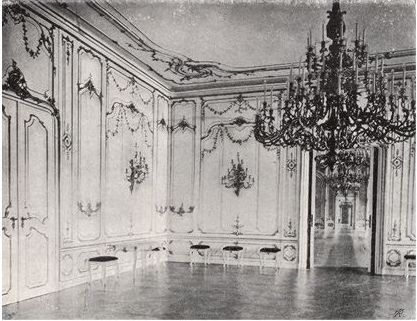 The Audience Antechamber (''Fogadási váróterem'') was situated north of the ballroom on the first floor of the Baroque wing. In the Baroque era it was called ''Antichambre Ihrer Majestät der Kaiserin'' ("Antechamber of HM The Empress"). The room gave access to Maria Theresa's private apartments from the ballroom. In the early 1900s, the audience antechamber became part of the ceremonial apartments and had the same white-golden Rococo stucco decoration as the white antechamber on the other side.
The Audience Antechamber (''Fogadási váróterem'') was situated north of the ballroom on the first floor of the Baroque wing. In the Baroque era it was called ''Antichambre Ihrer Majestät der Kaiserin'' ("Antechamber of HM The Empress"). The room gave access to Maria Theresa's private apartments from the ballroom. In the early 1900s, the audience antechamber became part of the ceremonial apartments and had the same white-golden Rococo stucco decoration as the white antechamber on the other side.
= Grand Throne Room
= The Grand Throne Room (''Nagy trónterem''), formerly known as the ballroom (''Nagyterem''), on the first floor of the Baroque wing had several layers of Baroque decoration from the second half of the 18th and the 19th century. Two surviving drawings record the oldest form of the room. Jakob Schmutzer's drawing from 1777 shows the opening ceremony of the Eötvös Loránd University after it was moved to the palace. The room had a Late Baroque decoration with double grooved Corinthian order, Corinthian pilasters between the windows and stucco garlands. The walls were decorated with Vinzenz Fischer's frescoes of the four faculties. József Pollencig's drawing from 1795 shows a ball scene in the "Prunksaal". The pilasters were kept, but the frescoes were already covered, and the whole room was stuccoed. On the vault the coat-of-arms of the Kingdom of Hungary can be seen. After the destruction of the 1849 siege, the room was redecorated in Neo-Baroque style. In 1892 the old ballroom was rebuilt with a new ceiling and a gallery towards the Lions Court; three of its side walls were preserved. It was enlarged again after 1896. The function of the ballroom was given to another new hall and this room was converted into the main throne hall instead. In the early 1900s, the room had a Rococo white-golden stucco decoration with three large chandeliers.
Vinzenz Fischer's frescoes were re-discovered in 1953 during the post-war reconstruction. In spite of this, all the decoration layers were destroyed. Today it houses the Gothic altar collection of the
The Grand Throne Room (''Nagy trónterem''), formerly known as the ballroom (''Nagyterem''), on the first floor of the Baroque wing had several layers of Baroque decoration from the second half of the 18th and the 19th century. Two surviving drawings record the oldest form of the room. Jakob Schmutzer's drawing from 1777 shows the opening ceremony of the Eötvös Loránd University after it was moved to the palace. The room had a Late Baroque decoration with double grooved Corinthian order, Corinthian pilasters between the windows and stucco garlands. The walls were decorated with Vinzenz Fischer's frescoes of the four faculties. József Pollencig's drawing from 1795 shows a ball scene in the "Prunksaal". The pilasters were kept, but the frescoes were already covered, and the whole room was stuccoed. On the vault the coat-of-arms of the Kingdom of Hungary can be seen. After the destruction of the 1849 siege, the room was redecorated in Neo-Baroque style. In 1892 the old ballroom was rebuilt with a new ceiling and a gallery towards the Lions Court; three of its side walls were preserved. It was enlarged again after 1896. The function of the ballroom was given to another new hall and this room was converted into the main throne hall instead. In the early 1900s, the room had a Rococo white-golden stucco decoration with three large chandeliers.
Vinzenz Fischer's frescoes were re-discovered in 1953 during the post-war reconstruction. In spite of this, all the decoration layers were destroyed. Today it houses the Gothic altar collection of the = White Antechamber
= The White Antechamber (''Fehér előterem'') is on the first floor of the Baroque wing and was situated south of the throne room. In the Baroque era it was called ''Zweytes Antichambre'' ("second antechamber"). In the early 1900s it had a Rococo white-golden stucco decoration with one chandelier and a white Rococo stove.
The White Antechamber (''Fehér előterem'') is on the first floor of the Baroque wing and was situated south of the throne room. In the Baroque era it was called ''Zweytes Antichambre'' ("second antechamber"). In the early 1900s it had a Rococo white-golden stucco decoration with one chandelier and a white Rococo stove.
= "Coronation" Room
= The "Coronation" Room (''"Koronázás" előterem''), also on the first floor of the Baroque wing, was situated next to the white antechamber. It opened from the main staircase of the southern wing and was the first room of the ceremonial apartments on that side. In the early 1900s it had a white-golden stucco decoration with one chandelier. The name of the chamber referred to the painting of Franz Joseph I's coronation as King of Hungary after the Austro-Hungarian Compromise of 1867.
The "Coronation" Room (''"Koronázás" előterem''), also on the first floor of the Baroque wing, was situated next to the white antechamber. It opened from the main staircase of the southern wing and was the first room of the ceremonial apartments on that side. In the early 1900s it had a white-golden stucco decoration with one chandelier. The name of the chamber referred to the painting of Franz Joseph I's coronation as King of Hungary after the Austro-Hungarian Compromise of 1867.
Old royal apartments
The old royal apartments are as follows:= Small Throne Room
= The Small Throne Room (''Kis trónterem''), which was situated next to the Audience Antechamber on the first floor of the Baroque wing. In the Baroque era it was called ''Audienz-Zimmer'' and was part of the Empress' private apartments. In Hauszmann's time it was converted into the throne room of the palace, with a simple Baroque throne under a baldachin. It had a white-golden stucco decoration with one chandelier and a Rococo cocklestove.
The Small Throne Room (''Kis trónterem''), which was situated next to the Audience Antechamber on the first floor of the Baroque wing. In the Baroque era it was called ''Audienz-Zimmer'' and was part of the Empress' private apartments. In Hauszmann's time it was converted into the throne room of the palace, with a simple Baroque throne under a baldachin. It had a white-golden stucco decoration with one chandelier and a Rococo cocklestove.
= "Circle" Tearoom
= The "Circle" Tearoom (''"Circle" teaszalon'') was on the first floor of the Baroque wing and situated next to the small throne room, in the corner of the southern wing. In the Baroque era it was called ''Gesellschaft Zimmer Ihrer Majestät der Kaiserin'' ("Parlour of HM The Empress") and was part of Maria Theresa's private apartments. In the early 1900s, it had a white-golden stucco decoration with one chandelier and a Rococo cocklestove. The furniture consisted of a Rococo parlour suite.
The "Circle" Tearoom (''"Circle" teaszalon'') was on the first floor of the Baroque wing and situated next to the small throne room, in the corner of the southern wing. In the Baroque era it was called ''Gesellschaft Zimmer Ihrer Majestät der Kaiserin'' ("Parlour of HM The Empress") and was part of Maria Theresa's private apartments. In the early 1900s, it had a white-golden stucco decoration with one chandelier and a Rococo cocklestove. The furniture consisted of a Rococo parlour suite.
= Antechamber
= The Antechamber was on the first floor of the Baroque wing and was situated next to the "circle" tearoom with two windows opening on to the Danube. In the Baroque era it was called ''Ankleide-Zimmer Ihrer Majestät der Kaiserin'' ("Dressing Chamber of HM The Empress") and was part of Maria Theresa's private apartments. It was connected to another small room, the ''Frauen Kammer''. In Hauszmann's time the walls were largely clad with wallpaper. The furniture consisted of a Rococo cocklestove, chairs and paintings. The last small room of the Empress, the former ''Schreib cabinet'' ("writing room"), with one window opening on to the Danube, later became a simple passageway.
The Antechamber was on the first floor of the Baroque wing and was situated next to the "circle" tearoom with two windows opening on to the Danube. In the Baroque era it was called ''Ankleide-Zimmer Ihrer Majestät der Kaiserin'' ("Dressing Chamber of HM The Empress") and was part of Maria Theresa's private apartments. It was connected to another small room, the ''Frauen Kammer''. In Hauszmann's time the walls were largely clad with wallpaper. The furniture consisted of a Rococo cocklestove, chairs and paintings. The last small room of the Empress, the former ''Schreib cabinet'' ("writing room"), with one window opening on to the Danube, later became a simple passageway.
= Smoking Room
=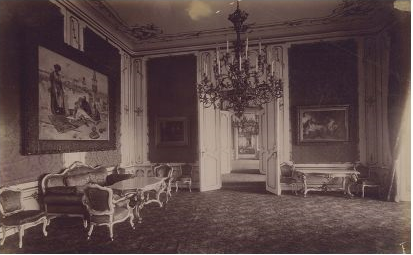 The Smoking Room (''Dohányzó szalon'') was on the first floor of the Baroque wing and was situated in the middle of the Danube side of the old palace. In the Baroque era it was called ''Schlafzimmer Ihrer k.k. Majestäten'' ("Bedchamber of Their Imperial and Royal Majesties"). It was the only common room of Empress Maria Theresa and her husband, Francis I. In the early 1900s, the walls were largely hung with wallpaper. The furniture consisted of a Rococo parlour suite and paintings. In the old imperial apartments only the ceilings had the typically white-golden stucco decoration, used in the old ceremonial apartments.
The Smoking Room (''Dohányzó szalon'') was on the first floor of the Baroque wing and was situated in the middle of the Danube side of the old palace. In the Baroque era it was called ''Schlafzimmer Ihrer k.k. Majestäten'' ("Bedchamber of Their Imperial and Royal Majesties"). It was the only common room of Empress Maria Theresa and her husband, Francis I. In the early 1900s, the walls were largely hung with wallpaper. The furniture consisted of a Rococo parlour suite and paintings. In the old imperial apartments only the ceilings had the typically white-golden stucco decoration, used in the old ceremonial apartments.
= Writing Room
=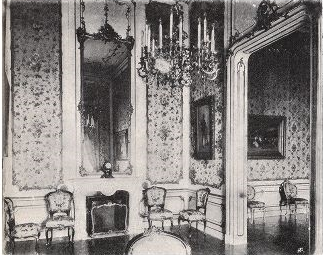 The Writing Room (''Írószoba'') was on the first floor of the Baroque wing, was formerly part of the private apartments of Francis I. One window opened to the Danube. In the Baroque era it was called ''Ankleidecabinet S.M. des Kaisers'' ("Dressing Chamber of HM The Emperor"). It was connected to another small room, the second dressing room. Later, the imperial dressing room was divided with a wall; with half being converted into a simple passageway, the other into a small writing room. In the early 1900s the latter's walls were largely clad with a very ornate Rococo wallpaper. It had a white marble mantelpiece with a large Rococo mirror above.
The Writing Room (''Írószoba'') was on the first floor of the Baroque wing, was formerly part of the private apartments of Francis I. One window opened to the Danube. In the Baroque era it was called ''Ankleidecabinet S.M. des Kaisers'' ("Dressing Chamber of HM The Emperor"). It was connected to another small room, the second dressing room. Later, the imperial dressing room was divided with a wall; with half being converted into a simple passageway, the other into a small writing room. In the early 1900s the latter's walls were largely clad with a very ornate Rococo wallpaper. It had a white marble mantelpiece with a large Rococo mirror above.
= Parlour
= The Parlour (''Társalkodó terem''), on the first floor of the Baroque wing, was part of the private apartments of Francis I, Holy Roman Emperor, Francis I. It was situated in the corner of the southern wing with 2+3 windows opening on to the Danube. In the Baroque era the room was divided with a wall, one half named ''Empfangs Zimmer S.M. des Kaisers'' ("Reception Chamber of HM The Emperor"), the other ''Arbeits Cabinet'' ("Study"). In Hauszmann's time, it was converted to a great parlour with wallpaper clad walls, a Rococo cocklestove, a chandelier, paintings, chairs and a mirror.
The Parlour (''Társalkodó terem''), on the first floor of the Baroque wing, was part of the private apartments of Francis I, Holy Roman Emperor, Francis I. It was situated in the corner of the southern wing with 2+3 windows opening on to the Danube. In the Baroque era the room was divided with a wall, one half named ''Empfangs Zimmer S.M. des Kaisers'' ("Reception Chamber of HM The Emperor"), the other ''Arbeits Cabinet'' ("Study"). In Hauszmann's time, it was converted to a great parlour with wallpaper clad walls, a Rococo cocklestove, a chandelier, paintings, chairs and a mirror.
= Antechamber
= The Antechamber, on the first floor of the Baroque wing, was the last room of the former private apartments of Francis I. In the Baroque era it was called ''Zweytes Audienz Zimmer'' ("second audience room"). In Hauszmann's time the walls were mainly clad with wallpaper, and it had a Rococo cocklestove, a chandelier, paintings and chairs.
The Antechamber, on the first floor of the Baroque wing, was the last room of the former private apartments of Francis I. In the Baroque era it was called ''Zweytes Audienz Zimmer'' ("second audience room"). In Hauszmann's time the walls were mainly clad with wallpaper, and it had a Rococo cocklestove, a chandelier, paintings and chairs.
South Wing
The rooms of the south wing are as follows:= Baroque Court
= The Baroque Court (''Barokk udvar''), a rectangular court, which is the oldest part of the Baroque palace. Here the original 18–19th century façades survived, and in 1997 the court was covered with a glass roof and became the main exhibition hall of the Budapest History Museum.= King's Staircase
=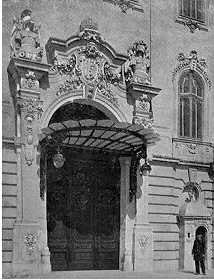 The King's Staircase (''Király-lépcső''), the Baroque main staircase of the southern wing gave access to the private apartments of Emperor Francis I. Both the King's Staircase and its northern twin, the Diplomat's Staircase, had ornate gates opening onto Lions Court, decorated with telamons. The kitchens were originally situated on the ground floor of the southern wing, but they were relocated by Hauszmann.
The King's Staircase (''Király-lépcső''), the Baroque main staircase of the southern wing gave access to the private apartments of Emperor Francis I. Both the King's Staircase and its northern twin, the Diplomat's Staircase, had ornate gates opening onto Lions Court, decorated with telamons. The kitchens were originally situated on the ground floor of the southern wing, but they were relocated by Hauszmann.
Central Wing
The central wing had the following rooms:= Diplomat's Staircase
= The Diplomat's Staircase (''Diplomata-lépcső'') was the Baroque main staircase of the central (originally northern) wing and gave access to the private apartments of Maria Theresa. In the 18th century there was an officer's dining room and a smaller kitchen on the ground floor and another dining room with a cafe kitchen on the first floor. The southern and northern (later central) wings had the same ground plan: all the rooms opened from a passageway running along the sides of a rectangular central court. The two monumental stairways were rebuilt by Hauszmann in Neo-Baroque style.= St Stephen's Chapel
=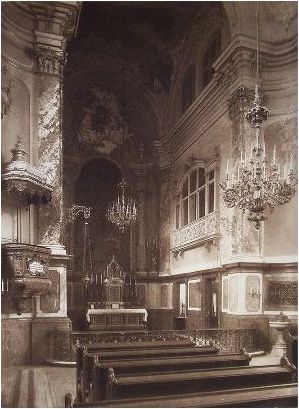 St Stephen's Chapel, known before as St. Sigismund Chapel, or Castle Church (''Szent Zsigmond-kápolna'', ''Vártemplom'') was the chapel royal in the western end of this wing, which had no façades, only a door opening onto Lions Court (through an antechamber). Construction was finished in 1768 and the church was consecrated in 1769. The ground plan was drawn by Nicolaus Pacassi, with the interior was designed by his follower, Franz Anton Hillebrandt. The ground plan followed a typical "violin" form favoured in the Baroque church architecture of Central Europe at that time. It had a rectangular chancel and a nave with four bays for side altars. On the first and the second floors two oratories opened into the chancel and a two-storey high gallery was situated above the entrance. In 1777–78 a new door was opened in the first side bay to give access to the new chapel of the Holy Right. An engraving from 1771 to 1780 shows the original interior design in its completed form: double pilasters, windows with segmental arches, stucco and false marble decoration, double oratory windows and a doorway with a stucco veil drawn aside by flying Putto, putti. The church was slightly rebuilt by Hauszmann, who demolished the Chapel of the Holy Right in 1899 and built a new chapel for the relic behind the chancel (converting a small recess). This chapel was decorated with the golden Venetian mosaics of Károly Lotz. A new Neo-Baroque main altar was built in the church in 1899.
20th-century photos testify that the church survived in its Baroque form until the war. During a siege, the vaults of the church partially collapsed and the furniture was plundered. The Castle Church was left decaying for more than a decade. In 1957 the remaining two vaults collapsed, and the church was totally destroyed and converted to exhibition spaces. The altar table was rescued and re-erected in Pilisvörösvár in 1957. The Lotz mosaics from the Chapel of the Holy Right were also rescued and re-assembled in Balatonalmádi.
St Stephen's Chapel, known before as St. Sigismund Chapel, or Castle Church (''Szent Zsigmond-kápolna'', ''Vártemplom'') was the chapel royal in the western end of this wing, which had no façades, only a door opening onto Lions Court (through an antechamber). Construction was finished in 1768 and the church was consecrated in 1769. The ground plan was drawn by Nicolaus Pacassi, with the interior was designed by his follower, Franz Anton Hillebrandt. The ground plan followed a typical "violin" form favoured in the Baroque church architecture of Central Europe at that time. It had a rectangular chancel and a nave with four bays for side altars. On the first and the second floors two oratories opened into the chancel and a two-storey high gallery was situated above the entrance. In 1777–78 a new door was opened in the first side bay to give access to the new chapel of the Holy Right. An engraving from 1771 to 1780 shows the original interior design in its completed form: double pilasters, windows with segmental arches, stucco and false marble decoration, double oratory windows and a doorway with a stucco veil drawn aside by flying Putto, putti. The church was slightly rebuilt by Hauszmann, who demolished the Chapel of the Holy Right in 1899 and built a new chapel for the relic behind the chancel (converting a small recess). This chapel was decorated with the golden Venetian mosaics of Károly Lotz. A new Neo-Baroque main altar was built in the church in 1899.
20th-century photos testify that the church survived in its Baroque form until the war. During a siege, the vaults of the church partially collapsed and the furniture was plundered. The Castle Church was left decaying for more than a decade. In 1957 the remaining two vaults collapsed, and the church was totally destroyed and converted to exhibition spaces. The altar table was rescued and re-erected in Pilisvörösvár in 1957. The Lotz mosaics from the Chapel of the Holy Right were also rescued and re-assembled in Balatonalmádi.
= Palatinal Crypt
=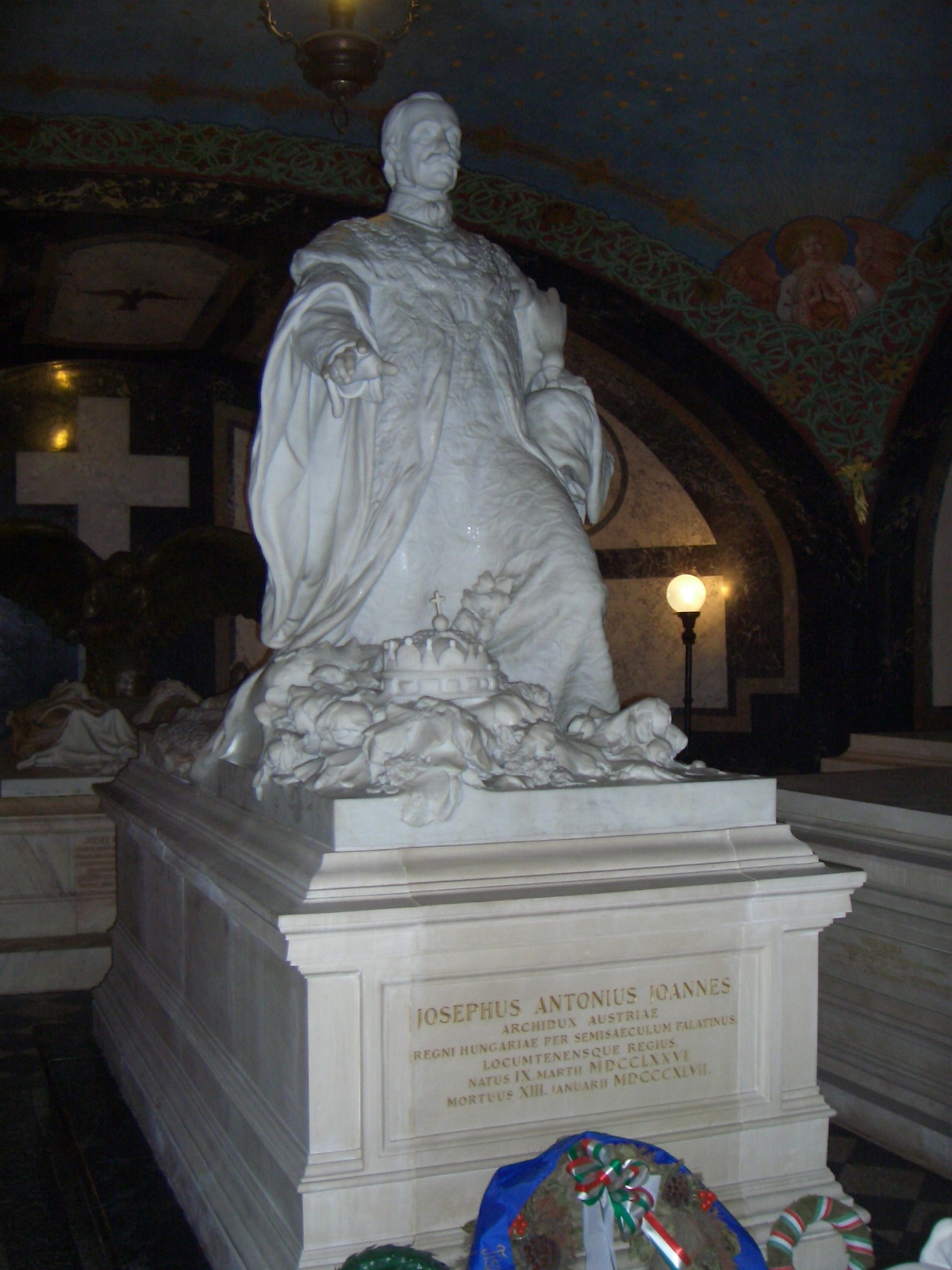 The
The North Wing
= Lobby
= The main lobby (''Előcsarnok'') of the Royal Palace was situated in Hauszmann's Northern Wing On the Danube side. It was a long, rectangular hall divided into four sections with free standing Ionic order, Ionic columns and two square pillars. The section at the southern end was elevated a few steps. Nine arched windows opened towards the Danube. In the middle of the other sidewall, a doorway led to the inner courtyard. The walls and the ceiling were stuccoed. The southern elevation was closed off with a stone balustrade between the pillars and the wall. The ornate lobby was designed for important state ceremonies.= Grand Ballroom
= The Grand Ballroom (''Nagy bálterem''), in the middle part of the northern wing, took over the function of the smaller old ballroom in the Baroque wing. Designed by Hauszmann, it was the most splendid room of the palace. The two-storey high, airy room was lavishly decorated with stuccoes, half columns, trabeation, balconies and six crystal chandeliers in Neo-Baroque style. Seven arched windows and doorways opened towards a pillared terrace facing the western forecourt. On the other side, the ballroom was connected to the Buffet Hall through three doors.
Photos made after the war show the room with its vaulted ceiling collapsed. The ballroom was not restored but totally destroyed in the course of the post-war remodelling.
The Grand Ballroom (''Nagy bálterem''), in the middle part of the northern wing, took over the function of the smaller old ballroom in the Baroque wing. Designed by Hauszmann, it was the most splendid room of the palace. The two-storey high, airy room was lavishly decorated with stuccoes, half columns, trabeation, balconies and six crystal chandeliers in Neo-Baroque style. Seven arched windows and doorways opened towards a pillared terrace facing the western forecourt. On the other side, the ballroom was connected to the Buffet Hall through three doors.
Photos made after the war show the room with its vaulted ceiling collapsed. The ballroom was not restored but totally destroyed in the course of the post-war remodelling.
= Dining Hall
= The Dining Hall (''Buffet-csarnok''), on the Danube side of the northern wing, was a very long hall used for state banquets. It was connected to the Great Ballroom nearby and it was possible to join them together. There was a shorter, passage-like space between the two rooms. This passage was separated from the Buffet Hall by six square pillars, while its other side was a solid wall with three doors. On the eastern side of the Buffet Hall a long row of windows opened towards the Danube and a pillared terrace. The Buffet Hall was divided into three sections with free-standing Ionic columns, holding trabeations. The vaulted ceiling was lavishly decorated with frescoes and stuccoes.
The Dining Hall (''Buffet-csarnok''), on the Danube side of the northern wing, was a very long hall used for state banquets. It was connected to the Great Ballroom nearby and it was possible to join them together. There was a shorter, passage-like space between the two rooms. This passage was separated from the Buffet Hall by six square pillars, while its other side was a solid wall with three doors. On the eastern side of the Buffet Hall a long row of windows opened towards the Danube and a pillared terrace. The Buffet Hall was divided into three sections with free-standing Ionic columns, holding trabeations. The vaulted ceiling was lavishly decorated with frescoes and stuccoes.
= Habsburg Hall
=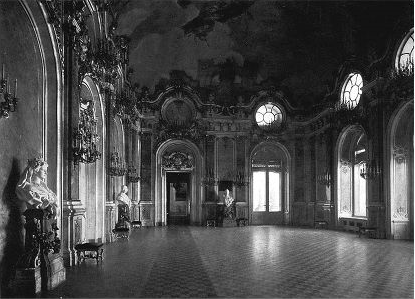 The Habsburg Hall (''Habsburg terem'') was situated in the middle of the long palace complex, under Hauszmann's (false) dome, where the new northern wing and the old palace met. Although this part of the building belonged to the original palace, it was thoroughly rebuilt by Hauszmann–this stately room was totally his own work. It was one of the three historical rooms of the palace representing the important periods of Hungarian history. A free-standing, double flight of steps, called the Habsburg Steps, connected the room with the Royal Gardens on the Danube terrace. The room had lavish Baroque decorations with half-pillars and gilded stuccoes. The vaulted ceiling was decorated with Károly Lotz's fresco ''Apotheosis of the Habsburg Dynasty''. Károly Senyei's four Carrara marble busts stood in front of the sidewalls representing King Charles III, Queen Maria Theresa, King Franz Joseph and Elisabeth of Bavaria, Queen Elisabeth.
The Habsburg Hall survived World War II relatively undamaged, but in the 1950s it was demolished for political reasons.
The Habsburg Hall (''Habsburg terem'') was situated in the middle of the long palace complex, under Hauszmann's (false) dome, where the new northern wing and the old palace met. Although this part of the building belonged to the original palace, it was thoroughly rebuilt by Hauszmann–this stately room was totally his own work. It was one of the three historical rooms of the palace representing the important periods of Hungarian history. A free-standing, double flight of steps, called the Habsburg Steps, connected the room with the Royal Gardens on the Danube terrace. The room had lavish Baroque decorations with half-pillars and gilded stuccoes. The vaulted ceiling was decorated with Károly Lotz's fresco ''Apotheosis of the Habsburg Dynasty''. Károly Senyei's four Carrara marble busts stood in front of the sidewalls representing King Charles III, Queen Maria Theresa, King Franz Joseph and Elisabeth of Bavaria, Queen Elisabeth.
The Habsburg Hall survived World War II relatively undamaged, but in the 1950s it was demolished for political reasons.
Krisztinaváros wing
 The Krisztinaváros wing faces the district of Krisztinaváros, which was named in honour of the daughter of Queen Maria Theresa, Archduchess Maria Christina, Duchess of Teschen.
The Krisztinaváros wing faces the district of Krisztinaváros, which was named in honour of the daughter of Queen Maria Theresa, Archduchess Maria Christina, Duchess of Teschen.
= Entrance hall
= The entrance hall (''Előcsarnok'') opened from Lions Court, under an arcaded Neo-Renaissance portico, through ornate wrought-iron doors. This now serves as the entrance of the Hungarian National Library. The hall was a long, oblong-shaped room with 4+4 free standing Ionic columns in front of the walls on the longer sides, holding a trabeation. In the end of the shorter sides two doors opened into antechambers. The three arcaded doorways on the longer side opened into a lobby. The ceiling of the hallway was stuccoed, and the whole design was Italian Renaissance in style.= Lobby
=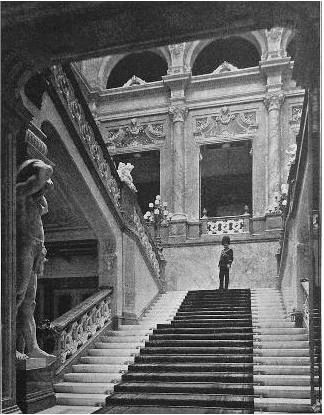 The lobby (''Előcsarnok'') was connected to the hall of the main staircase through pillars. The stuccoed ceiling was held up by two rectangular pillars. The apartments of Archduke József Ágost and his wife, Archduchess Auguszta, were situated on the ground floor of the Krisztinaváros wing and opened from this room. Now it serves as the lobby of the Hungarian National Library in a radically modernised form.
The lobby (''Előcsarnok'') was connected to the hall of the main staircase through pillars. The stuccoed ceiling was held up by two rectangular pillars. The apartments of Archduke József Ágost and his wife, Archduchess Auguszta, were situated on the ground floor of the Krisztinaváros wing and opened from this room. Now it serves as the lobby of the Hungarian National Library in a radically modernised form.
= Main Staircase
= The monumental main staircase (''Főlépcsőház''), with three flights, led up from the lobby to the first floor in an airy, glass-roofed hall. The side walls of the hall were decorated in Italian Renaissance style with colossal Corinthian half-columns, stuccoes and lunette openings. Ornate wrought-iron chandeliers and intricate balustrades decorated the stairs. On the ground floor, colossal Atlas (architecture), Atlas statues stood beside the side pillars, holding the weight of the upper flights. The marble statues were the works of János Fadrusz from 1897. During the post-war reconstruction the main staircase was radically modernised. Only the two colossal Atlas statues survived. Now they are standing somewhat incongruently near their original places.= St Stephen's Room
= St Stephen's Room (''"Szent István" terem''), on the first floor of the Krisztinaváros wing, was one of the "historical rooms" of the palace, created by Hauszmann. Together with the Matthias Room and the Habsburg Room, they represented the three most important periods of History of Hungary, Hungarian history. Saint Stephen's Room connected the new Private Royal Apartments and—through a very long passageway—the Old Royal Apartments in the Danube Wing. Its style evoked the age of the Árpáds, the first Hungarian dynasty in the early Middle Ages. The walls were clad with dark carved wood paneling. The most spectacular item was a large stone mantelpiece with Romanesque Revival architecture, Romanesque Revival architectural details and the bust of King Stephen I of Hungary, Saint Stephen, the first king of Hungary. The room was furnished with medieval-looking metal chandeliers and heavy wooden furniture. It was completely destroyed in World War II.
In 2016 however, the reconstruction of St Stephen's Room (as the first step towards the eventual reconstruction of the entire caslte) was announced. After years of meticulous research and work, the room was accurately restored and it was opened to public on August 20, 2021.
St Stephen's Room (''"Szent István" terem''), on the first floor of the Krisztinaváros wing, was one of the "historical rooms" of the palace, created by Hauszmann. Together with the Matthias Room and the Habsburg Room, they represented the three most important periods of History of Hungary, Hungarian history. Saint Stephen's Room connected the new Private Royal Apartments and—through a very long passageway—the Old Royal Apartments in the Danube Wing. Its style evoked the age of the Árpáds, the first Hungarian dynasty in the early Middle Ages. The walls were clad with dark carved wood paneling. The most spectacular item was a large stone mantelpiece with Romanesque Revival architecture, Romanesque Revival architectural details and the bust of King Stephen I of Hungary, Saint Stephen, the first king of Hungary. The room was furnished with medieval-looking metal chandeliers and heavy wooden furniture. It was completely destroyed in World War II.
In 2016 however, the reconstruction of St Stephen's Room (as the first step towards the eventual reconstruction of the entire caslte) was announced. After years of meticulous research and work, the room was accurately restored and it was opened to public on August 20, 2021.
= Matthias Room
= Matthias Room (''Mátyás terem'') was named after King Matthias Corvinus, who ruled in the late Middle Ages. It was one of the three "historical rooms" of the palace, created by Hauszmann. The room opened from the Royal Bedroom, at the end of the line of private apartments. It had three windows opening towards the hills of Buda. There was a long terrace in front of the room. The style of the Matthias Room was Renaissance architecture, Renaissance, with carved wooden paneling and a coffered ceiling. It was furnished with a mantelpiece in the corner and two chandeliers, the most spectacular item being the equestrian statue of King Matthias, sculpted by János Fadrusz. The statue was a miniature copy of the original standing on the main square of Kolozsvár (now Cluj-Napoca). This copy was saved after the war and put on display in the Hungarian National Gallery.
Matthias Room (''Mátyás terem'') was named after King Matthias Corvinus, who ruled in the late Middle Ages. It was one of the three "historical rooms" of the palace, created by Hauszmann. The room opened from the Royal Bedroom, at the end of the line of private apartments. It had three windows opening towards the hills of Buda. There was a long terrace in front of the room. The style of the Matthias Room was Renaissance architecture, Renaissance, with carved wooden paneling and a coffered ceiling. It was furnished with a mantelpiece in the corner and two chandeliers, the most spectacular item being the equestrian statue of King Matthias, sculpted by János Fadrusz. The statue was a miniature copy of the original standing on the main square of Kolozsvár (now Cluj-Napoca). This copy was saved after the war and put on display in the Hungarian National Gallery.
= Strong Room
= The Hungarian crown jewels were kept in the specially-designed Strong Room (''Páncélterem'') on the second floor of the Krisztinaváros Wing. The Crown of Saint Stephen was kept here between 1900 and 1944.= Queen Elisabeth Memorial Museum
= The small Queen Elisabeth Memorial Museum (''Erzsébet Királyné Emlékmúzeum'') on the second floor of the Krisztinaváros Wing was established in remembrance of Queen Elisabeth after her murder in 1898. Memorabilia were collected by Ida Ferenczy, Elisabeth's former lady-in-waiting, Viscountess Pallavicini and Countess Ilona Batthyány. The museum opened on 15 January 1908 as an affiliate of thePrivate royal apartments
= Royal Entrance Hall
= The Royal Entrance Hall (''Fejedelmi előterem''), on the first floor of the Krisztinaváros Wing, gave access to the rooms of the Private Royal Apartments of King Franz Joseph I. The private apartments were situated in the southwestern part of the Krisztinaváros wing, their windows opening towards the hills of Buda. The Royal Entrance Hall was connected through a wide passageway to the main staircase hall. The spacious, oblong-shaped hall was divided in three, with two pairs of Ionic marble columns supporting architraves. The central part of the room was much longer than the bays at the ends. Doors connected the hall with the rooms of the private apartments. In the middle of the longer wall stood an ornate stone mantelpiece with the bust of Franz Joseph. On the other side, three windows opened to the inner courtyard of the Krisztinaváros wing. The ceiling was stuccoed and the side walls of the hall were covered with marble.
The Royal Entrance Hall (''Fejedelmi előterem''), on the first floor of the Krisztinaváros Wing, gave access to the rooms of the Private Royal Apartments of King Franz Joseph I. The private apartments were situated in the southwestern part of the Krisztinaváros wing, their windows opening towards the hills of Buda. The Royal Entrance Hall was connected through a wide passageway to the main staircase hall. The spacious, oblong-shaped hall was divided in three, with two pairs of Ionic marble columns supporting architraves. The central part of the room was much longer than the bays at the ends. Doors connected the hall with the rooms of the private apartments. In the middle of the longer wall stood an ornate stone mantelpiece with the bust of Franz Joseph. On the other side, three windows opened to the inner courtyard of the Krisztinaváros wing. The ceiling was stuccoed and the side walls of the hall were covered with marble.
= Antechamber
= The antechamber (''Előterem'') of the private apartments opened from the Royal Entrance Hall. It had three windows facing toward the hills. The room had a typical Biedermeier white-golden stucco decoration with floral wallpapers, resembling to the cosy rooms of Schönbrunn Palace. All the rooms of the private apartments followed this Viennese style favoured by the King. The antechamber was furnished with a stone mantelpiece (with a mirror above), an Empire (style), Empire crystal chandelier, a stone flowerpot standing on a fluted column and Neo-Renaissance table with chairs.
The antechamber (''Előterem'') of the private apartments opened from the Royal Entrance Hall. It had three windows facing toward the hills. The room had a typical Biedermeier white-golden stucco decoration with floral wallpapers, resembling to the cosy rooms of Schönbrunn Palace. All the rooms of the private apartments followed this Viennese style favoured by the King. The antechamber was furnished with a stone mantelpiece (with a mirror above), an Empire (style), Empire crystal chandelier, a stone flowerpot standing on a fluted column and Neo-Renaissance table with chairs.
= Audience Room
= The audience room (''Fogadószoba'') of Franz Joseph I was situated in a corner of the private apartments wing, with two windows opening southwards and three windows opening westwards. It had a beautiful stuccoed and frescoed ceiling. The walls were covered with floral wallpapers. The room was furnished with a crystal chandelier, a golden Rococo console table with a large mirror and a parlour suite.
The audience room (''Fogadószoba'') of Franz Joseph I was situated in a corner of the private apartments wing, with two windows opening southwards and three windows opening westwards. It had a beautiful stuccoed and frescoed ceiling. The walls were covered with floral wallpapers. The room was furnished with a crystal chandelier, a golden Rococo console table with a large mirror and a parlour suite.
= Writing Room
=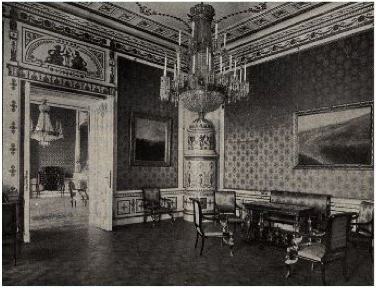 The writing room (''Írószoba'') of Franz Joseph had two windows opening towards the hills of Buda. It had a white-golden stuccoed ceiling and the walls were covered with floral wallpapers. The room was furnished with a crystal chandelier, an ornate white cocklestove, a table and chairs. To the right and left two similar parlours opened from the room.
The writing room (''Írószoba'') of Franz Joseph had two windows opening towards the hills of Buda. It had a white-golden stuccoed ceiling and the walls were covered with floral wallpapers. The room was furnished with a crystal chandelier, an ornate white cocklestove, a table and chairs. To the right and left two similar parlours opened from the room.
= Royal Bedroom
= The bedroom (''Fejedelmi hálószoba'') of the king had two windows opening towards the hills of Buda. It had a white-golden stuccoed ceiling and the walls were covered with floral wallpapers. The room was furnished with a crystal chandelier, the baldachined royal bed and a folding screen. The bedroom was connected to a dressing room, a private bathroom and smaller rooms belonging to the butler and the servants.
The bedroom (''Fejedelmi hálószoba'') of the king had two windows opening towards the hills of Buda. It had a white-golden stuccoed ceiling and the walls were covered with floral wallpapers. The room was furnished with a crystal chandelier, the baldachined royal bed and a folding screen. The bedroom was connected to a dressing room, a private bathroom and smaller rooms belonging to the butler and the servants.
= Royal Dining Hall
=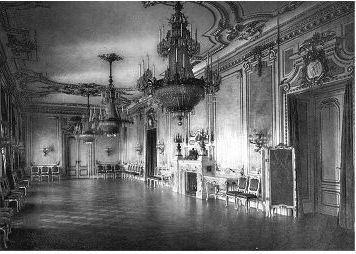 The Royal Dining Hall (''Fejedelmi ebédlő'') opened from the Royal Entrance Hall, and it was the largest room of the private apartments. The long hall had six windows opening towards Gellért Hill. Three crystal chandeliers gave light to the elegant stuccoed space. In the middle of the longer side wall, between the two doors, stood a marble mantelpiece.
The Royal Dining Hall (''Fejedelmi ebédlő'') opened from the Royal Entrance Hall, and it was the largest room of the private apartments. The long hall had six windows opening towards Gellért Hill. Three crystal chandeliers gave light to the elegant stuccoed space. In the middle of the longer side wall, between the two doors, stood a marble mantelpiece.
= "Circle" Room
= The "Circle" Room (''"Circle" terem'') opened from the Royal Dining Hall. It was the last room of the private apartments on the southern side, with three windows opening towards Gellért Hill. It had a white-golden stuccoed ceiling and the walls were covered with floral wallpapers. The room was furnished with a crystal chandelier, an ornate white cocklestove and chairs.
The "Circle" Room (''"Circle" terem'') opened from the Royal Dining Hall. It was the last room of the private apartments on the southern side, with three windows opening towards Gellért Hill. It had a white-golden stuccoed ceiling and the walls were covered with floral wallpapers. The room was furnished with a crystal chandelier, an ornate white cocklestove and chairs.
= Dining Room
= The small dining room (''Ebédlő'') was situated in the northern part of the Krisztinaváros wing, among the other rooms of the Royal Guest Suite. Four windows opened towards Krisztinaváros. The ceiling was stuccoed, while the walls were covered with carved wooden panelling and wallpaper. A stone mantelpiece and large painting above it (depicting a hunting scene with a deer) gave a homey feeling to the room. It was furnished with a crystal chandelier and a long dining table with 12 chairs.
The small dining room (''Ebédlő'') was situated in the northern part of the Krisztinaváros wing, among the other rooms of the Royal Guest Suite. Four windows opened towards Krisztinaváros. The ceiling was stuccoed, while the walls were covered with carved wooden panelling and wallpaper. A stone mantelpiece and large painting above it (depicting a hunting scene with a deer) gave a homey feeling to the room. It was furnished with a crystal chandelier and a long dining table with 12 chairs.
Archducal Apartments
These apartments, on the ground floor of the Krisztinaváros Wing, were designed in 1902 for Archduke Joseph August of Austria (1872–1962), the head of the Hungarian branch of the Habsburgs and his wife, Princess Auguste of Bavaria (1875–1964), Archduchess Augusta (1875–1964). They could be reached from the lobby of the Krisztinaváros wing through a long passageway. The most important rooms were (in due course): the ''salon'', where guests were entertained; the ''great parlour''; ''parlour''; ''dining room''; the ''Archduke's study''; the ''Archduke's bedroom''; the ''Archduchess' bedroom''; the ''Archduchess' study''; and the ''breakfast parlour''. All rooms had a relatively simple decoration with white stuccoed ceilings and stucco panels above the doorways. The walls were covered with wallpaper. Crystal chandeliers, stone mantelpieces and typical turn-of-the-century furniture gave the rooms a homey ambiance. The great parlour was decorated with large paintings.Works of art
The castle and its gardens have been decorated with works of art since their foundation in the 14th century. Only written sources speak about the most important medieval works, but detailed pictorial and written information exists about the 19th-century artistic decoration of the palace, which was mainly created by the most important Hungarian artists of the era. Many of the statues survived the destruction during the siege of Budapest in 1944–45 and were later restored. On the other hand, important works of art were destroyed during the controversial reconstruction of the castle during the 1950s and 1960s.Sculptural monuments
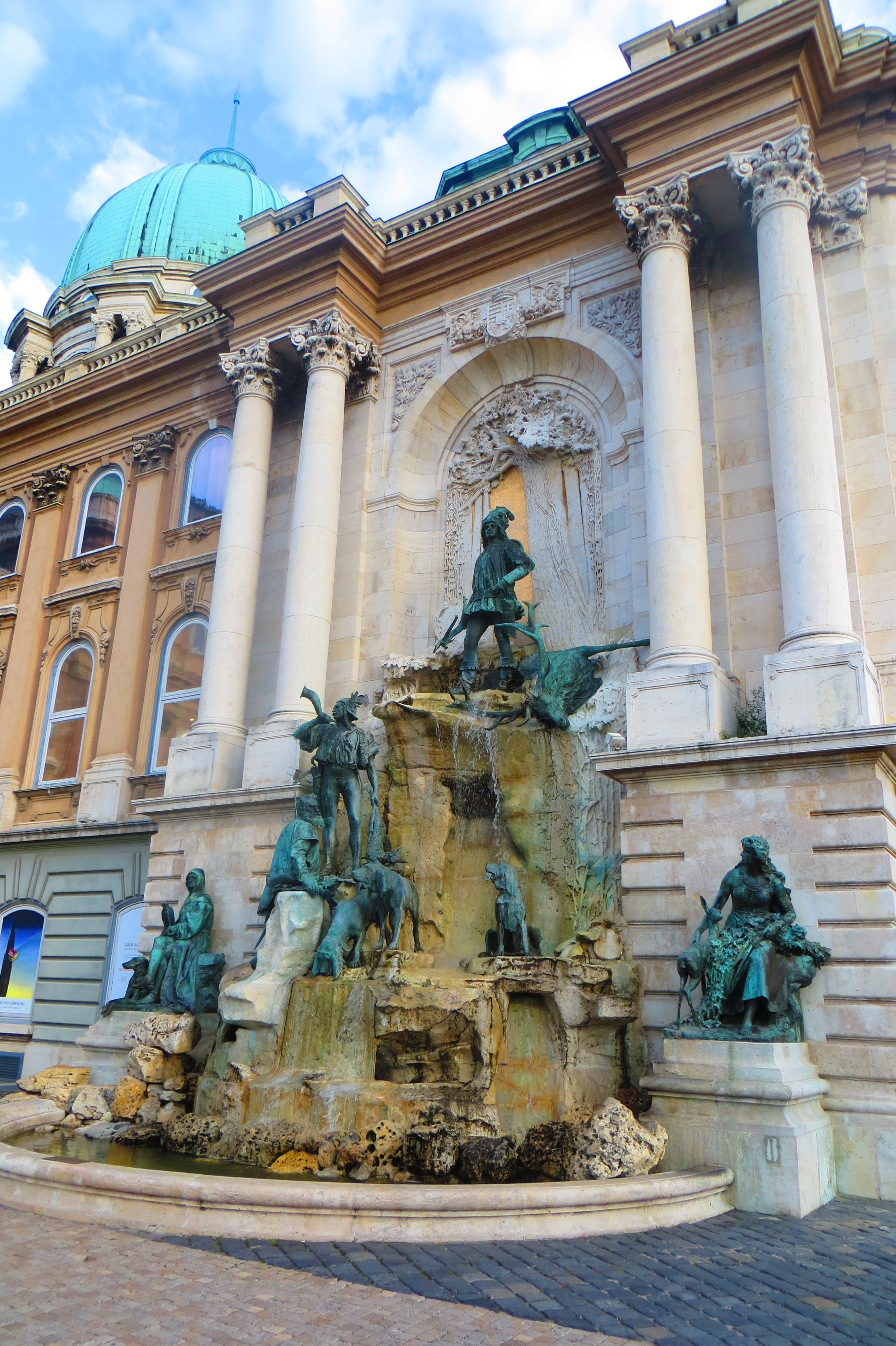 ;Matthias Fountain (''Mátyás kútja'')
The spectacular fountain decorates the western forecourt of the palace. It shows a group of hunters led by King Matthias Corvinus together with hounds, a killed deer, Galeotto Marzio with a hawk and Szép Ilonka with a doe. This group of people stands between fallen rocks with water running down into a basin. The fountain was made by sculptor Alajos Stróbl. The dead deer was modelled upon a majestic stag killed in 1896 by poachers in the forest owned by Stróbl. The damaged sculpture was restored after the war. Nowadays it is probably the most photographed object in the palace.
;Monument of Prince Eugene of Savoy
The equestrian statue of Prince Eugene of Savoy stands on the Danube terrace, in a prominent position, high above Budapest. The Neo-Baroque statue was made by sculptor József Róna for the town of Senta, Zenta, but the town could not afford the price. The monument was bought in 1900 as a temporary solution until the planned equestrian statue of King Franz Joseph was completed. This never happened, so Prince Eugen remained on his plinth. The plinth is decorated with two bronze reliefs showing the capture of the earth-works in Zenta and the decisive cavalry charge in the Battle of Zenta in 1697.
;Matthias Fountain (''Mátyás kútja'')
The spectacular fountain decorates the western forecourt of the palace. It shows a group of hunters led by King Matthias Corvinus together with hounds, a killed deer, Galeotto Marzio with a hawk and Szép Ilonka with a doe. This group of people stands between fallen rocks with water running down into a basin. The fountain was made by sculptor Alajos Stróbl. The dead deer was modelled upon a majestic stag killed in 1896 by poachers in the forest owned by Stróbl. The damaged sculpture was restored after the war. Nowadays it is probably the most photographed object in the palace.
;Monument of Prince Eugene of Savoy
The equestrian statue of Prince Eugene of Savoy stands on the Danube terrace, in a prominent position, high above Budapest. The Neo-Baroque statue was made by sculptor József Róna for the town of Senta, Zenta, but the town could not afford the price. The monument was bought in 1900 as a temporary solution until the planned equestrian statue of King Franz Joseph was completed. This never happened, so Prince Eugen remained on his plinth. The plinth is decorated with two bronze reliefs showing the capture of the earth-works in Zenta and the decisive cavalry charge in the Battle of Zenta in 1697.
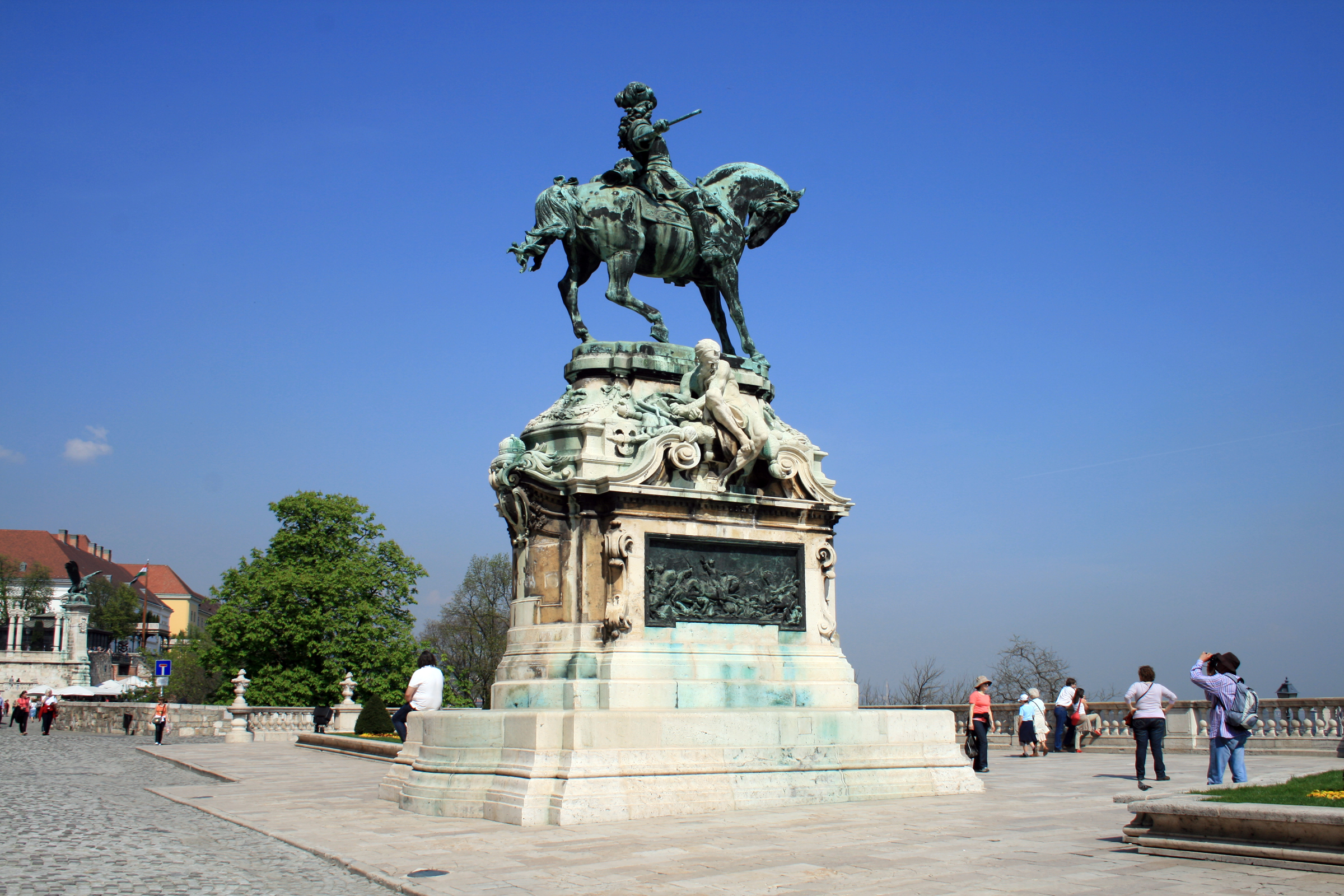
 ;Horseherd (''Csikós'')
The statue of the Hortobágy National Park horseherd taming a wild horse originally stood in front of the Riding School in the former Újvilág terrace. It is the work of György Vastagh from 1901. The statue was displayed in the Exposition Universelle (1900), Exposition Universelle in Paris (1900). The damaged statue was removed during the 1960s, but it was later restored and erected in the western forecourt of the palace in 1983, next to the Matthias Fountain. It was moved back to its original location in front of the restored riding school in 2021.
;Turulbird (''Turulmadár'')
The mythological Turul, high above the Danube, was made by Gyula Donáth in 1905. The plinth and the ornate Neo-Baroque rail (Gyula Jungfer's work) was seriously damaged during the siege of Buda, but they were restored in 1981, together with the broken coat-of-arms of the Kingdom of Hungary on the plinth.
;Horseherd (''Csikós'')
The statue of the Hortobágy National Park horseherd taming a wild horse originally stood in front of the Riding School in the former Újvilág terrace. It is the work of György Vastagh from 1901. The statue was displayed in the Exposition Universelle (1900), Exposition Universelle in Paris (1900). The damaged statue was removed during the 1960s, but it was later restored and erected in the western forecourt of the palace in 1983, next to the Matthias Fountain. It was moved back to its original location in front of the restored riding school in 2021.
;Turulbird (''Turulmadár'')
The mythological Turul, high above the Danube, was made by Gyula Donáth in 1905. The plinth and the ornate Neo-Baroque rail (Gyula Jungfer's work) was seriously damaged during the siege of Buda, but they were restored in 1981, together with the broken coat-of-arms of the Kingdom of Hungary on the plinth.
 The monumental allegorical bronze statues of War and Peace stand beside the entrance to the Budapest History Museum. They are the work of Károly Senyei. Both War and Peace are represented by angels, one with a trumpet, the other with an olive branch. Under the angel of Peace is a returning soldier, while under the angel of War there is a dead Ottoman soldier and ancient Hungarian warriors.
There are sepulchral monuments in the Palatinal Crypt decorated with the statues of György Zala (sculptor), György Zala, Alajos Stróbl and Károly Senyei.
The monumental allegorical bronze statues of War and Peace stand beside the entrance to the Budapest History Museum. They are the work of Károly Senyei. Both War and Peace are represented by angels, one with a trumpet, the other with an olive branch. Under the angel of Peace is a returning soldier, while under the angel of War there is a dead Ottoman soldier and ancient Hungarian warriors.
There are sepulchral monuments in the Palatinal Crypt decorated with the statues of György Zala (sculptor), György Zala, Alajos Stróbl and Károly Senyei.
Lost works of art
;Hungaria The monumental sculpture group decorated the main (northern) façade of the palace, facing Szent György Square. On the top of the attic, crowning the façade, stood the female figure of Hungaria, the allegorical representation of Hungary. Two semi-nude figures sat at her side, one male and one female, representing Industry and Commerce. The group was made by sculptor Gyula Jankovits in 1905. The sculpture was destroyed, together with the whole northern façade, during the 1950s. ;Pediment Group The pediment above the Habsburg Steps was decorated with an allegorical group of Károly Senyei representing the ''Apotheosis of the Dual Monarchy''. It was destroyed during the 1950s, together with the great coat-of-arms of the Kingdom of Hungary which originally crowned the façade. The present-day pediment is plain, without any sculptural decoration. ;Apotheosis of the Habsburg Dynasty The ceiling of the Habsburg Room was decorated with a fresco representing the apotheosis of the Habsburg Dynasty. It was the last important work of Károly Lotz, painted in 1903, one year before his death. The artist was already seriously ill when he worked on the fresco. The "Apotheosis" followed the traditions of Baroque court painting, and the work was praised by contemporary critics. The fresco survived the war unscathed, but it was destroyed in the 1950s.Museums and institutions
The cellars and caves
During the Ottoman era, the extensive cave system was utilized by the hunters to store tigers and Hungarian mountain bears. The cellars stored an ornate wine collection from the Egri wine growing region in the Northern frontier of Hungary.Honors
Postage stamps depicting the castle were issued by Hungary on 26 March 1926 on 1 June 1967 on 30 April 1986See also
* Archduke Joseph's Palace * Gödöllő Palace, summer residence of the Hungarian monarchs * The House of Houdini * Medieval Royal Palace (Buda Castle) * Palace Chapel (Buda Castle) *References
Notes
* László Prohászka: Szoborhistóriák, Bp, 2004, pp. 145–150.Further reading
History
Károly Magyar: The Royal Palace of Buda
in the online database The Castle of Buda (online database), The Castle of Buda * Miklós Horler: Budapest műemlékei I, Bp: 1955, pp. 259–307 * György Kelényi: A királyi udvar építkezései Pest-Budán a XVIII. században, Bp: Akadémiai Kiadó, 2005, pp. 27–34 * György Kelényi: A királyi udvar építkezései Pest-Budán a XVIII. században, Bp: Akadémiai Kiadó, 2005, pp. 34–38 * László Gerő: A helyreállított budai vár, Bp, 1980, pp. 11–60.
Péter Farbaky: Magyar újkori építészet
External links
*Buda Castle live webcam
Aerial photographs of the Castle
Nemzeti Hauszmann Program Website - Information about the reconstruction of the Budapest Royal Palace
Interior
– with grounds plan and photos.
Works of art
*{{Authority control Buda Castle, Castles in Hungary Buildings and structures in Budapest Landmarks in Hungary Palaces in Hungary Royal residences in Hungary Várkerület Tourist attractions in Budapest World Heritage Sites in Hungary Buildings and structures completed in 1265 Houses completed in the 13th century Houses completed in the 15th century Houses completed in 1769 Houses completed in 1912 Art Nouveau houses Art Nouveau architecture in Budapest Baroque architecture in Hungary Baroque Revival architecture Medieval architecture 13th-century establishments in Hungary Neoclassical architecture in Hungary